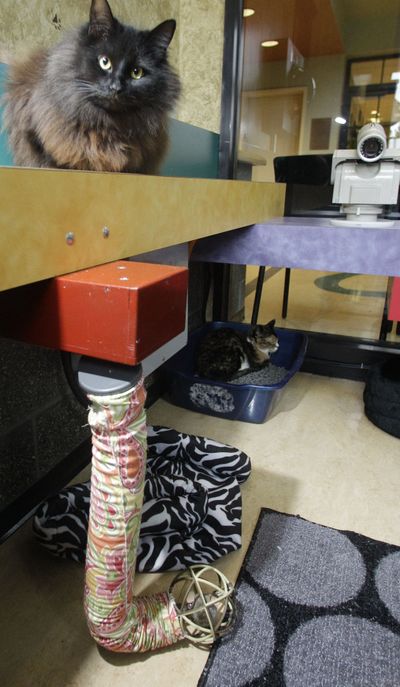Use your mouse to play with a cat
Technology allows people to remotely interact with shelter animals

PORTLAND – More than 90,000 cat lovers from 112 countries have played with the kittens at the Oregon Humane Society since September, wiggling and yanking on kitty toys at the shelter’s play room.
You’d think such a large number of people would be tripping over each other. But these visits are by remote, thanks to real-time technology that lets fans of felines use their computers to manipulate the toys, which dangle from robotic arms.
It’s a game of cat and computer mouse.
The kitties whack and tug at the toys and occasionally tumble with each other while their human playmates watch via cat-cam.
Cats being cats, sometimes they ignore the toys, too.
The technology, called iPetCompanion, was invented by a small Idaho robotics company, Apriori Control, and was first tested by the Idaho Humane Society in Boise last June.
“After launching our first site live in Idaho, we received an enormous response from Humane Societies around the country,” said Scott Harris, head of Apriori.
He chose the Oregon Humane Society for the next launch.
“All I had to do was provide space and kittens,” said Barbara Baugnon, communications director at the Portland shelter.
One purpose of the program is to increase cat adoptions by letting would-be owners play with the cats without having to travel to the shelters.
That’s working. Adoptions are up 16 percent at the Oregon Humane Society, and have increased at the Boise shelter as well.
But it’s not the whole point. People overseas who have played with the Idaho and Oregon kittens are probably not about to book a flight to the Pacific Northwest to adopt a cat.
Still, they benefit. Interacting with cats can have a soothing effect on humans, even if it is done remotely.
Some of the human playmates are people who can’t own cats, whether because of building rules, allergies or other reasons. Disabled people with limited mobility also play with the kitties.
The average interactive time per viewer at the Idaho shelter is nearly 14 minutes; at the Oregon shelter it’s just shy of 15 minutes, said Harris.
The Idaho site has had more than 86,000 unique visitors from 108 countries. For both shelters, the greatest number of visitors have been American, followed by Germans, Australians, Canadians, Britons, Estonians and Swiss.
Some 71.3 percent of people who visit the Idaho site come back again; that rate in Oregon is 85.6.
And having humans available to play 24/7 can be good for the felines’ mental and physical health as well.
“The basic idea of an online kitty play room is great for both people who are, for one reason or another, unable to play with their own cat, and for the kittens, to help with socialization, reduce boredom in the shelter and promote later adoption,” said Dr. Dennis C. Turner, an author and researcher in animal behavior at the University of Zurich in Switzerland.
“I hope this innovation will be adopted by other shelters throughout the world,” Turner, an expert on cat behavior and human-cat relations, said in an e-mail.
Baugnon, at the Oregon shelter, hopes the interactive play rooms will help more people understand that cats need attention from their human owners, just as dogs do.
“Over the years, dogs have been elevated in status. Now they’re members of the family,” she said.
Cats, she worries, sometimes get unequal treatment.
“We want people to understand cats aren’t OK by themselves. We are hoping people realize these are beings that want to be part of the family,” Baugnon said.
There have been some glitches. During the first week, the kittens at the Idaho shelter broke all of the toy mechanisms in the play room, said Dr. Jeff Rosenthal, executive director at the Idaho Humane Society.
The mechanisms were toughened up to withstand the “destructive capacity of a roomful of kittens.”
Currently, you have to use Internet Explorer to interact with the kittens, but Harris is working on that. He also said he is working with a large pet-toy distributor interested in selling iPetCompanion.
While hundreds of other shelters have expressed interest, Harris said, the $8,200 installation cost is an obstacle unless sponsors can be found to foot the bill.
In the meantime, he said, the technology is being put to other uses as well – including plans to control the feeding of an even bigger cat, a zoo lion, over the Internet.